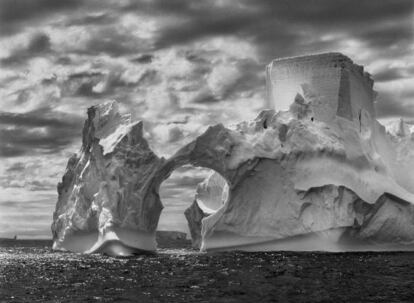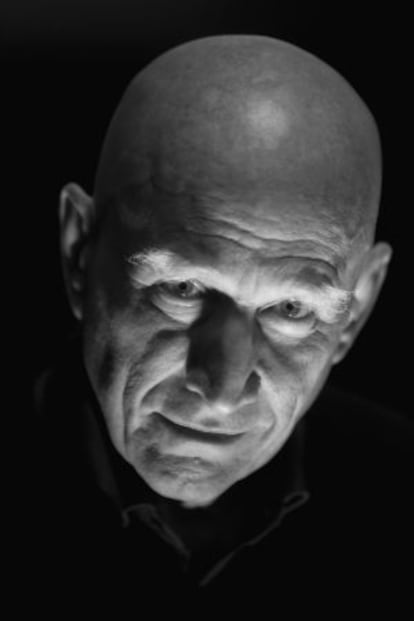A new book of Genesis
CaixaForum Madrid exhibits 245 of the images taken by Brazilian photographer Sebastião Salgado in some of the most inaccessible places on the planet

Water, fire, earth, light: the four elements that God combined to create the world offer a diverse range of variables, but under the eye of Brazilian photographer Sebastião Salgado, they multiply infinitely, and can even break the rules. If for example, the Creator made clear that crocodiles should crawl along the ground until they submerge under water, the Brazilian photographer can suggest to us, thanks to the exceptional vision that he extracts from his lenses, that they also fly. Visitors to the CaixaForum in Madrid can see this for themselves when they look at the 245 photographs on display in Génesis, a collection that required more than eight years of traveling around the planet in search of paradise to create.
Why? In order to emulate the eye of God, but by being true to Darwin; to bear witness to the origins of life that remain intact; to certify that water still runs, that light is a magic spring that penetrates like a paintbrush, mutating the infinite black-and-white suggestions that Salgado shows our world to be. To experience, close up, via the world and its paths, everything that is told in the sacred texts, but to also follow the evolution of species; to prove that penguins exist, to compare iguana scales and the enormous shells of Galapagos tortoises; to explain that indigenous peoples have the map of their understanding tattooed on their bodies next to that of the rivers and the forests; and that both elephants and icebergs emulate fortresses of ice and skin; and that geology designs monuments and that there are still natural sanctuaries we can hold on to.
Born in Aimorés, in southeastern Brazil, in 1944, Salgado did not expect to be in such good shape at his age. But when he decided to get involved in this adventure, which has taken up all his time and energy, he surprised himself by climbing peaks of up to 4,200 meters, wandering through wetlands, penetrating forests, and being at the mercy of the desert to capture what he has captured. "It is also a return to my origins, to my childhood in Brazil, when I used to undertake long journeys on foot, alongside my father, moving cattle, and the distances were relative," he says.

This is how he learned to look. Slowly. And to be patient, as he reveals in his memoirs De mi tierra a la Tierra (From my land to the Earth), which have just been published in Spanish. As well as the highlights of his career, the book describes how somebody on whom life had smiled, a respected economist, ended up becoming a photographer who when he started out lacked even the resources to support himself. And how he moved from the air-conditioned offices of international organizations to sleeping among tribes, earning the trust of miners and oil workers — which led to his project La mano del hombre (The hand of man) — and showing the effects of global migration before the phenomenon was understood in his book Exoduses . In Génesis, Salgado has achieved an inner journey that anybody can undertake, either by visiting the exhibition or by immersing themselves in the spectacular accompanying book published by Taschen. The mutant laws of the universe manifest themselves in it. "I do not believe that there is an established order, but I do believe that there is a common and natural evolution between minerals, animals, and vegetables, an interaction," he explains.
To show it, he has walked, managing to extract thousand-year-old energies from routes such as the one that links the pilgrimage site of Lalibela and the Simien National Park in Ethiopia. In total, 850 kilometers on foot over three months. "The journey of my life," he says. The odyssey required a team of 15 people and 18 mules to transport food and equipment. "This enabled me to experience what is told in the Old Testament, how people used to travel, how they lived," he says. Salgado and his team followed paths that have been used by man for at least 5,000 years and remain intact.
He would wake each morning at around 5am and then trek for up to 30 kilometers, taking 10 or 12 hours to do so. He had no real schedule or plans: "Obviously, I had to stop to take pictures." His wife, Leila, joined him from the only spot she could reach by car from Addis Ababa, and then walked with him for 350 kilometers. It is impossible to understand Salgado's work without his life companion, who designs his catalogues and exhibitions, accompanies him on his journeys, and encourages him to undertake new projects.
This is how Sebastião Salgado has chosen to portray the roots that hold us to the Earth, through environments where the tiger still reigns, protected by caves and routes from where he observed the luminous tide that mutates the forests and the sand of the deserts, the serpentine erosion of springs, where women, without saying a word, wash a traveler's feet, as well as offering their breasts to feed a newcomer's children. Where life is to be found in its savage order, with its laws acclimatized to the necessary pact of the balance that we are losing in other places.
Génesis. Sebastião Salgado. Until May 4 at CaixaForum Madrid, Paseo del Prado 36, Madrid. http://obrasocial.lacaixa.es
Tu suscripción se está usando en otro dispositivo
¿Quieres añadir otro usuario a tu suscripción?
Si continúas leyendo en este dispositivo, no se podrá leer en el otro.
FlechaTu suscripción se está usando en otro dispositivo y solo puedes acceder a EL PAÍS desde un dispositivo a la vez.
Si quieres compartir tu cuenta, cambia tu suscripción a la modalidad Premium, así podrás añadir otro usuario. Cada uno accederá con su propia cuenta de email, lo que os permitirá personalizar vuestra experiencia en EL PAÍS.
¿Tienes una suscripción de empresa? Accede aquí para contratar más cuentas.
En el caso de no saber quién está usando tu cuenta, te recomendamos cambiar tu contraseña aquí.
Si decides continuar compartiendo tu cuenta, este mensaje se mostrará en tu dispositivo y en el de la otra persona que está usando tu cuenta de forma indefinida, afectando a tu experiencia de lectura. Puedes consultar aquí los términos y condiciones de la suscripción digital.
Últimas noticias
Reinhard Genzel, Nobel laureate in physics: ‘One-minute videos will never give you the truth’
Pinochet’s victims grapple with José Antonio Kast’s rise in Chile
From digital curfews to blocking apps: How technology experts protect their children online
Why the price of coffee has skyrocketed: from Brazilian plantations to specialty coffee houses
Most viewed
- Pablo Escobar’s hippos: A serious environmental problem, 40 years on
- Why we lost the habit of sleeping in two segments and how that changed our sense of time
- Trump’s obsession with putting his name on everything is unprecedented in the United States
- Charles Dubouloz, mountaineering star, retires at 36 with a farewell tour inspired by Walter Bonatti
- The Florida Keys tourist paradise is besieged by immigration agents: ‘We’ve never seen anything like this’








































